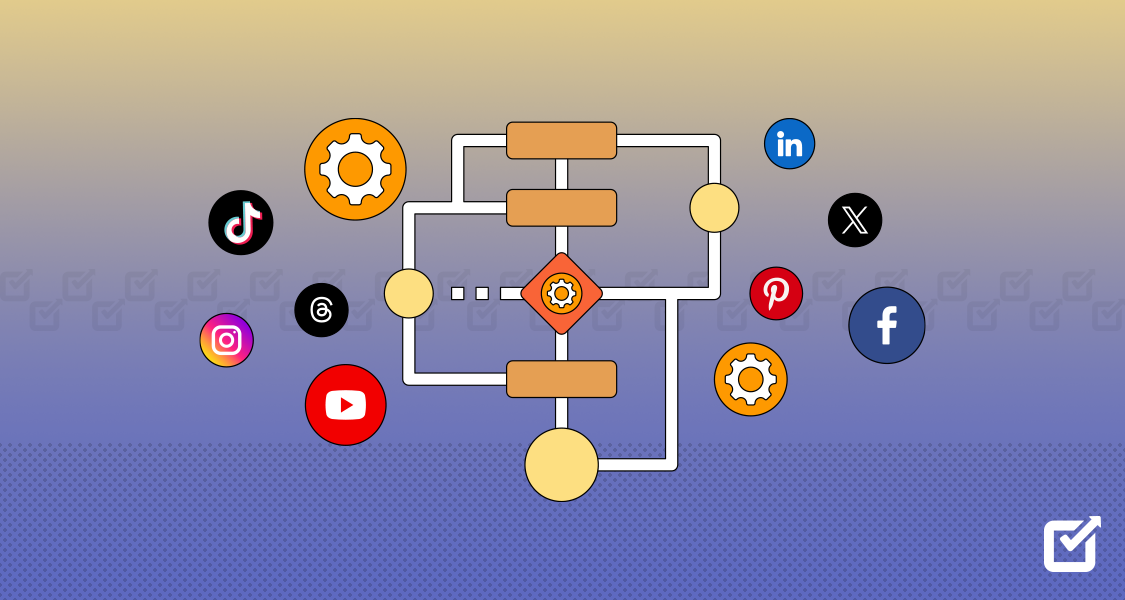Here’s a fascinating fact – 73% of customers utilize multiple channels during their online shopping journey. This means that today’s consumers are no longer confined to a single avenue when making purchasing decisions. They traverse a diverse landscape of online platforms, seeking information, validation, and a seamless experience.
So, whether you’re a seasoned marketer or just dipping your toes into the digital marketing waters, you should master the art of cross channel marketing sooner rather than later. And that’s not all! You should leverage a social media management tool, as it can simplify the process of coordinating your messages across various cross channel marketing platforms.
What is Cross Channel Marketing?
Cross-channel marketing refers to the strategic use of multiple marketing channels to reach and engage with a target audience. Cross-channel marketing aims to create a seamless and cohesive experience for consumers across various social media sites and touch points.
Imagine a potential customer engaging with your brand through various channels – perhaps they stumble upon your engaging social media content, receive a personalized email, and then explore your user-friendly website. Each interaction contributes to a more comprehensive and immersive brand experience.
Whether it’s through personalized emails, targeted social media campaigns, or a seamless website experience, the goal is to create a consistent brand identity that resonates at every turn.
Manage Your Brand Across Diverse Social Platforms With Social Champ!
Seamlessly manage and amplify your presence on various channels from one centralized hub.
Difference Between Cross-Channel Marketing and Multichannel Marketing
The main difference between cross-channel marketing and multichannel marketing lies in how the various marketing channels are integrated and work together to create a cohesive customer experience.
Multichannel marketing involves using multiple independent channels to interact with customers. These channels operate in silos, each having its own strategy and goals. For example, you might conduct social media marketing, email marketing, and content marketing, each functioning independently.
Think of multichannel marketing as having different tools in a toolbox. You use each tool for a specific purpose, but they might not necessarily work together seamlessly.
On the other hand, cross-channel marketing is a more integrated approach where various channels work together to provide a unified and consistent customer experience. The focus is on creating a seamless journey for the customer as they move between different channels.
Imagine a relay race where each runner passes the baton smoothly to the next. Cross-channel marketing is like ensuring a smooth handoff between different channels. If a customer sees a product on social media, they should seamlessly find more information in an email and then easily complete the purchase on the website.
In essence, multichannel marketing involves using multiple channels independently, while cross-channel marketing isn’t just about being present everywhere; it’s about crafting a narrative that remains consistent, relevant, and compelling, regardless of where your audience encounters it.
Related Article: Cross Posting on Social Media: Is it Useful in 2025?
5 Compelling Reasons Why You Should Use Cross-Channel Marketing
You’re already marketing your brand on various channels; why should you care about cross-channel marketing? Well, there are several reasons why you should focus your efforts more on cross channel marketing.
Here are several statistics that emphasize the importance of using cross-channel marketing:
Multichannel Shoppers Spend More
According to a Harvard Business Review study, customers who engage with businesses across multiple channels have been found to spend 4% more in physical stores and 10% more online compared to their single-channel counterparts. This underscores the direct correlation between cross-channel engagement and increased spending behavior.
Increased Engagement With Cross-Channel Strategies
Reports indicate that businesses employing cross-channel marketing experience 166% more engagement compared to those utilizing only a single-channel approach. This statistic highlights the potency of cross-channel strategies in capturing and retaining audience attention across diverse cross channel marketing platforms.
Customer Expectations for Seamless Experiences
A significant 90% of consumers expect a consistent experience across all channels, including online and offline interactions with a brand. This emphasizes the growing demand for consistency and integration in customer experiences, making cross-channel marketing a necessity to meet these expectations.
Higher Conversion Rates With Cross-Channel Campaigns
Reports reveal that businesses incorporating cross-channel campaigns witness a 24% higher conversion rate compared to those relying on single-channel efforts. This substantial difference in conversion rates underscores the impact of a coordinated and integrated marketing approach in driving desired customer actions.
Increased Revenue for Cross-Channel Adopters
Businesses that implement a cross-channel approach report an average revenue increase of 23% compared to those that do not. This compelling statistic highlights the direct correlation between cross-channel marketing adoption and significant financial growth, making it a key driver for overall business success.
10 Benefits of Cross Channel Marketing
The above statistics collectively emphasize the importance of cross-channel marketing by showcasing its impact on customer spending, engagement rates, conversion efficiency, and overall revenue growth.
But the question here is: what benefits can your business enjoy by adopting a cross channel marketing strategy? Well, here are 10 benefits of cross-channel marketing, as well as cross channel marketing examples:
Consistent Branding
With cross-channel marketing, you can maintain a consistent brand image across different channels. Consistency in messaging, visuals, and tone helps reinforce your brand identity, making it more memorable for your audience.
Note how TimeBucks maintains consistency in their messaging across different channels below:

Image from Facebook 
Image from Telegram 
Image from Email Expanded Reach
Cross-channel marketing allows you to connect with your audience on various platforms, such as social media channels, email, websites, and more. This broader reach ensures that your message can reach potential customers wherever they are, increasing the chances of engagement.
See how DSTV markets its brand on various platforms below:

A snapshot of Instagram post This screenshot is from @dstv_kenya Instagram, now let’s check out DStv on Facebook!

A snapshot of a Facebook post Enhanced Customer Experience
By coordinating marketing efforts across channels, you provide a seamless and integrated experience for your customers. They can transition effortlessly between platforms, enjoying a cohesive journey that fosters a positive and memorable interaction with your brand.
See how fitkenyangirl incorporates links on her marketing campaigns to direct customers:

A snapshot of an Instagram post Improved Customer Understanding
Utilizing multiple channels also allows you to gather data on customer behavior, preferences, and interactions. This comprehensive understanding enables you to tailor your marketing strategies to better meet the needs and expectations of your audience.
Optimized Campaign Performance
Cross-channel marketing enables you to analyze the performance of your campaigns across different platforms. By identifying what works well in each channel, you can optimize your marketing strategies for better overall results.
Adaptability to Customer Behavior
We’ve established the fact that modern-day customers use various channels during their buying journey. Cross channel marketing allows you to adapt to changing customer behavior and preferences, ensuring that your business remains relevant and responsive to evolving trends.
Increased Engagement and Conversion
Engaging with customers through multiple channels increases the likelihood of capturing their attention. A cohesive and well-coordinated approach boosts engagement and can lead to higher conversion rates as customers move through the sales funnel.
Efficient Resource Utilization
Instead of investing heavily in a single marketing channel, diversifying your approach through cross channel marketing allows you to allocate resources strategically. This can result in a more cost-effective and efficient use of your marketing budget.
Swift Issue Resolution
In case of misunderstandings or discrepancies, cross channel marketing provides the flexibility to address issues promptly. This responsiveness builds trust with your audience, showcasing your commitment to delivering a reliable and customer-centric experience.
Stay Competitive in a Dynamic Landscape
The digital landscape is constantly evolving. Embracing cross channel marketing ensures that your business stays competitive by adapting to emerging technologies, platforms, and trends, keeping you ahead of the curve.
How to Get Started With Cross-Channel Marketing
Getting started with cross channel marketing involves a strategic approach to seamlessly integrate your marketing efforts across various platforms.
Here’s a step-by-step guide to help you embark on your cross channel marketing journey:
Define Your Objectives
First and foremost, you should clearly outline your marketing goals and what you aim to achieve through cross-channel efforts. Whether it’s increasing brand awareness, driving sales, or improving customer retention, having well-defined objectives provides a roadmap for your cross channel marketing strategy.
Know Your Audience
All marketing strategies require that you get to know your target audience, and cross-channel marketing is no exception. So, you should analyze your target audience’s preferences, behaviors, and the channels they frequent. This knowledge will help you tailor your messages to resonate with your audience across different platforms.
Select Relevant Channels
Not every channel may be suitable for your business. Some channels cater to a younger demographic, such as Snapchat, some appeal to more mature audiences, like LinkedIn, and others that appeal to diverse groups, such as Facebook. So, be sure to choose platforms that align with your audience and objectives.
Create Consistent Messaging
I cannot overemphasize the importance of developing a cohesive brand message that can be adapted across channels. Consistency in tone, visuals, and content helps build a recognizable brand identity, fostering trust and reliability among your audience.
Utilize a Customer-Centric Approach
Another crucial thing to do is to focus on the customer journey. You can do so by mapping out the various touch points customers encounter throughout their interaction with your brand. Then, you should ensure that your messaging is tailored to each stage of their journey, from awareness to conversion and beyond.
Integrate Data and Analytics
You should also leverage data analytics tools to gather insights from different channels. This data-driven approach allows you to track performance, understand customer behavior, and optimize your cross channel marketing campaigns for better results.
Implement Marketing Automation
You can also consider using marketing automation tools to streamline your cross-channel efforts. Automation ensures timely and consistent messaging, facilitates personalized interactions, and enables efficient management of multiple channels simultaneously.
Supercharge Your Cross-Channel Marketing Efforts With Social Champ!
Unleash the power of marketing automation to schedule, analyze, and optimize your social media content seamlessly.
Coordinate Campaign Timing
You should also plan and coordinate your cross channel marketing campaigns to avoid conflicting messages and ensure a unified customer experience. This includes synchronizing the timing of promotions, product launches, and other marketing activities.
Test and Optimize
It’s also crucial that you regularly test different elements of your campaigns, such as headlines, visuals, and calls-to-action, across various channels. Use A/B testing to understand what resonates best with your audience and continuously optimize your approach.
Monitor and Adapt
Lastly, keep a close eye on key performance indicators (KPIs) and adapt your strategy based on real-time data. Also stay informed about industry trends and changes in consumer behavior to remain agile in your cross-channel marketing efforts.
Remember, cross-channel marketing is an ongoing process that requires flexibility and adaptation. By following the 10 steps above and continuously refining your strategy based on feedback and results, you can build a robust cross-channel marketing approach that maximizes your brand’s impact across the digital landscape.
Related Article: Instagram Analytics: Key Metrics to Monitor in 2025
Challenges of Cross-Channel Marketing
Navigating the landscape of cross-channel marketing, while promising significant rewards, comes with its own set of challenges. As you strive to deliver a seamless and integrated experience across various platforms, you may grapple with obstacles, such as:
Technological Hurdles
One major obstacle in cross channel marketing is the integration of diverse technologies. Different channels often operate on separate systems, making it challenging to synchronize data and ensure a smooth flow of information across platforms.
To overcome this hurdle, you can invest in advanced marketing technology solutions and social media management tools that offer seamless integration capabilities. This can allow for a unified view of customer data and facilitates coordinated campaigns.
Consistency in Messaging
Maintaining a consistent brand message across various channels can be challenging. Differences in tone, visuals, or content can create confusion for customers and dilute the overall brand identity.
To ensure consistency, you should establish comprehensive brand guidelines and employ centralized content management systems. Regular communication and training with marketing teams across channels are also crucial to align messaging strategies.
Data Security and Privacy Concerns
The collection and utilization of customer data across multiple channels raise concerns about privacy and security. Striking a balance between personalization and respecting customer privacy is a delicate challenge in cross-channel marketing.
To quell your customers’ concerns, you should implement robust data security measures and comply with relevant data protection regulations. Being transparent with customers about data usage and giving them control over their preferences can build trust and mitigate concerns.
Customer Journey Complexity
Another significant challenge presents itself during mapping out the increasingly complex customer journey, involving various touch points across channels. The nonlinear nature of modern customer journeys makes it difficult to predict their paths accurately.
Regularly analyzing data and adapting strategies based on evolving customer journeys can help you stay ahead.
Resource Allocation and Budgeting
Allocating resources and budget effectively across multiple channels can also be challenging. It’s essential to avoid overinvestment in one channel at the expense of others, leading to an imbalanced marketing strategy.
Moreover, conducting thorough channel performance analyses and leveraging data to identify high-performing channels can inform resource allocation decisions. Adopting a flexible budgeting strategy that allows for adjustments based on channel performance is also advisable.
As you can see, there are challenges that are bound to come your way as you start your cross-channel marketing journey. The good news is that there are ways you can overcome those challenges and achieve your marketing goals.
Conclusion
As you strive to engage your target audience effectively and build lasting relationships, staying abreast of evolving trends and adapting to changing consumer behaviors is paramount. Now that modern-day customers prefer using multiple channels when making their purchase decisions, it’s crucial that you embrace a holistic cross channel marketing approach.
Luckily, there are tools that can significantly enhance the implementation and management of cross-channel marketing campaigns. One such valuable tool is Social Champ, which provides a robust cross channel marketing platform for scheduling, analyzing, and optimizing social media content. With its advanced features, this social media management tool empowers businesses to streamline your cross-channel efforts, ensuring a synchronized and impactful presence across social platforms.





















2 thoughts on “Cross Channel Marketing in 2025: Get Started with Handy Tips & Examples”
Excellent resource for diving into cross-channel marketing in 2024. The tips and examples are incredibly practical and useful!
“Incredible guide! The tips and examples for Cross Channel Marketing in 2024 are so practical. Can’t wait to try them out!”